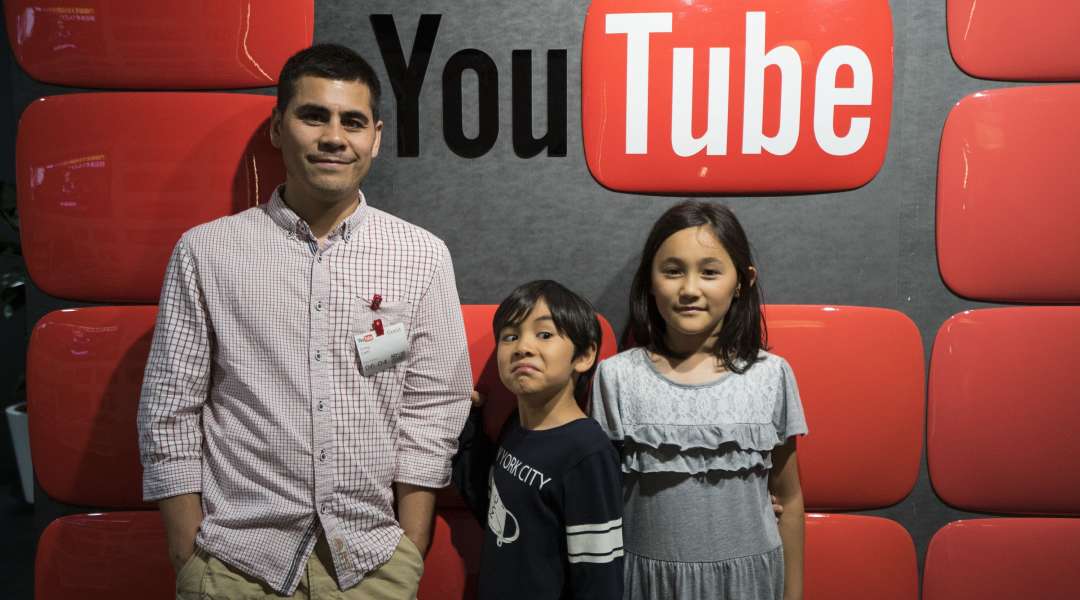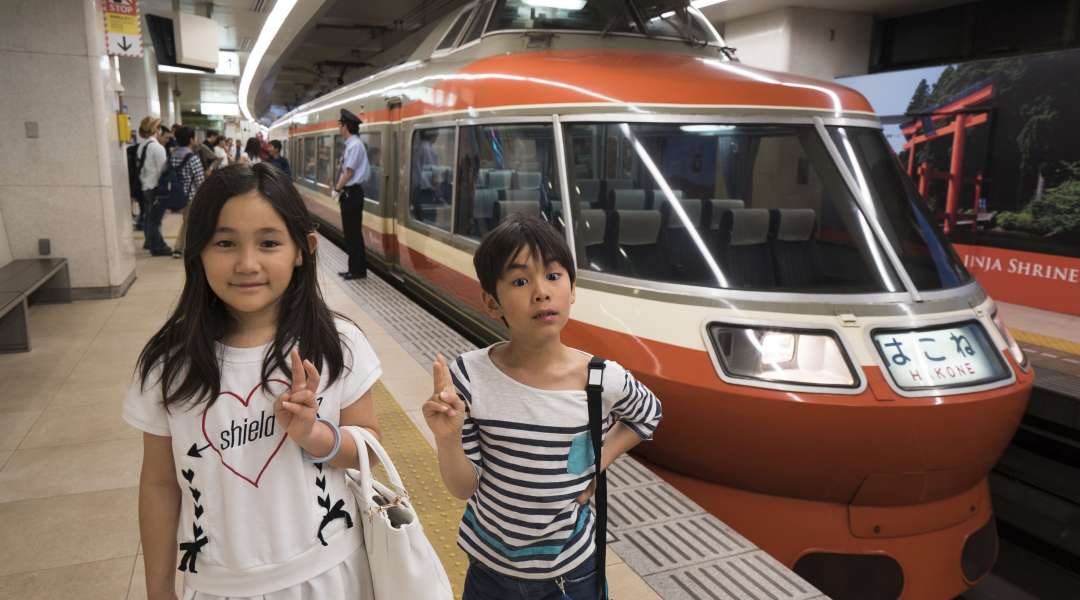
In 2013 Greg moved to Tokyo with his Japanese wife and two children. He sent some videos from Japan to his family in Canada and was surprised by their very positive reaction. That's how he started his YouTube channel 'Life Where I'm From' where he tries to show everyday Japan to his viewers. Nowadays his channel has over 1.5 million subscribers and he even started creating short documentaries which means his videos were definitely succesful in sparking people's interest! We talked about his life in Japan and went in deep on family travel in Japan both in the interview and in our recent Instagram Live when Greg shared his expert tips!

Hi, thanks for talking to us today. Could you tell us a little about yourself?
Perhaps counterintuitively, I don't like talking about myself very much. I'm Canadian and grew up in the prairies of Winnipeg before moving to the coast and mountains of Vancouver as an adult. At the age of 33 I moved with my wife (who is Japanese) and two kids to Tokyo. My kids have roughly spent half their lives in Canada and half in Japan.
For the past few years I've made my living making videos on YouTube. The videos are mostly about Japanese culture, with a focus on mini-documentaries and everyday life.

What drew you to move to Japan? How did you find it after living in Canada?
When my wife and I got married we had planned to live half our time in Canada and half in Japan. After 12 years of living in Canada we finally made the move to Japan.
However, the big motivator for the timing of the move was the 2011 Tōhoku earthquake and tsunami. My wife wanted to be near her family.
The last big reason we moved to Japan was because we wanted our kids to experience both countries, cultures, and families. And of course be fluent in both English and Japanese.
Moving to Japan I found I had a lot more time for my family than I did in Canada. That's because I was able to work remotely from home for American and Canadian companies. I found I had the time to walk my son to daycare and be home for my kids when they returned from school. So I skipped having to work in a Japanese company, which would have been a much different experience.
Even though I had visited Tokyo a half dozen times over 13 years, I was still very concerned about living in Japan. I didn't speak the language well at all (despite having a Japanese family and taking a couple Japanese courses at university) and I was concerned about air quality and the quality of life in general.
It turns out that learning Japanese is a lifelong endeavour that's easily the hardest academic thing I've ventured on in my life. The air quality in Tokyo is great, and because we live in a quiet part of Tokyo near the river, I find the quality of life is better than what I had in Canada. I really love being able to bike and walk around the city without the need for a car.

What inspired you to start your YouTube channel ‘Life Where I’m From’? Which video was the most fun to film?
I was inspired to start my YouTube channel Life Where I'm From after sending some footage to my brother and seeing how my nieces reacted. They were so fascinated about normal, everyday things in Japan.
I also saw that on YouTube a lot of the content about Japan was about weird or niche things. Also, there wasn't much content from the perspective of children. So, as a fun side project, I had my kids explain about everyday life in Japan and asked viewers to send in footage from where they're from so that kids could see what life is like around the world.
It turns out that compiling good quality videos from around the world is tough, but that people really enjoyed seeing videos about everyday Japanese life.

As the channel gained more viewers, people started asking more complicated questions, which is why I started making mini-documentaries about topics like homelessness, school lunch, work life, and being a shokunin (which is hard to directly translate, but think of them as really dedicated artisans).
One of the most enjoyable videos to film was the one where my daughter made a dinner only using ingredients from 7-Eleven. It was supposed to be a parody of all the chef reality shows / documentaries on Netflix, where a passionate chef takes the viewer through how they make their culinary masterpieces.
My daughter, Aiko, took 7-Eleven food and made a whole multi-course dinner menu for her brother, Shin. Even though it was a parody, my daughter took it seriously and it was really nice to make a zero pressure video where I didn't have to worry about fact-checking. We all just had fun making and eating the food. And at the end of the day, I still think it has some educational value, since all the food we made really is the kind of stuff you can buy at the very convenient convenience stores in Japan.

Do you have any advice for people who want to explore Japan with younger children?
I would say that if you avoid the busy places you'll have a much more enjoyable time and it'll be a lot more affordable as well. So while you can have fun at the major tourist attractions, try some local things as well.
For example, when my brothers visited with their kids, they really enjoyed bike riding to different parks and having picnics using food bought at the supermarkets or convenience stores. There are some really great kid-oriented parks that have climbing structures, traffic parks, and even some that have petting zoos or pony rides. These kinds of parks are free. There are also athletic parks, which generally cost under one thousand yen per kid, and are like giant outdoor obstacle courses.

Most kids like noodles, so eating ramen, udon, or soba are usually a safe bet with kids. Going to some family restaurants or food courts will also give the whole family a chance to easily try out a variety of dishes. It'll be much less intimidating than going to specialty shops where their menus might be all in Japanese without any pictures. But if you have a local that can show you around, then I'd definitely try many of the specialty shops they have (from yakitori, to sushi, to tonkatsu).
Getting around, just be aware that you'll probably be taking a lot of public transportation. I'd get an IC card, which will generally work all over Japan, and will let you tap-and-pay for trains and buses. Make sure to tell your kids that riding on Japanese trains is like being in a library: talk very softly and don't climb on the seats.

The last thing I'll say is that public run facilities, like museums or aquariums, and zoos can be quite affordable yet very high quality. So try and visit some.
What are some must-see attractions for families visiting Japan for the first time?
Uh oh, I think I answered some of this in my previous question. Besides parks and museums, my family members all enjoyed visiting a ryokan, which is a traditional Japanese Inn. It's a bit pricey, as you pay per person as opposed to by the room, but you generally get dinner and breakfast plus access to an onsen (hot springs). Some facilities have kashikiri-buro or kazoku-buro (which are hot springs you can exclusively reserve for 50 minutes for only your family's use) and some even have onsen baths in your own room. The kids will enjoy wearing yukata and ryokans are generally located in areas that are outside of the city and fun to explore.

There are more traditional ryokans, which are generally more remote and quiet, and then there are modern hotel ryokans, which can have big buffets, swimming pools, and amusement facilities. The adults will probably prefer the former, whereas the kids will probably prefer the latter.
If you find yourself in Tokyo, I'd recommend taking the ferry ride from Asakusa to Odaiba. There are fun things to do in both places and you can see some great scenery from the ferry.
You can find Greg and his family on his YouTube channel, website, Instagram, Twitter, and Facebook!

















































